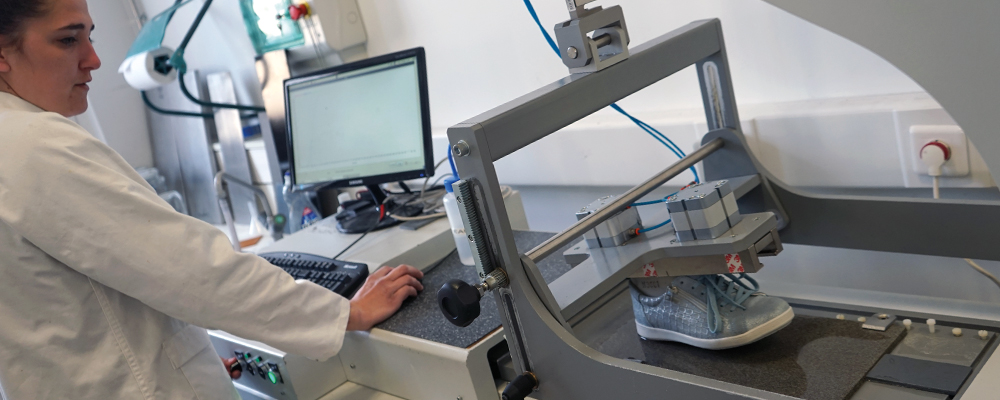


Drawing on its expertise in testing and PPE CE marking, CTC puts forward a test method that meets the expectations of those responsible for marketing city and leisure footwear.
In France, the Permanent survey of day-to-day accidents (EPAC) (1) estimated at almost 11% the share of the population that had a day-to-day accident (AcVC) in 2017. Furthermore, almost 50% of accidents involve falling due to slipping. It is the most frequent domestic accident.
These accidents are often considered to be harmless. However, they can cause very serious injury, ranging from permanent disability to even death.
The parts of the body mainly affected by a fall are, first, the lower limbs (feet, tibia, femur, etc.) and then the upper limbs (hands, elbows, wrists), due to the person’s inability to fall safely.
These accidents especially concern children and the elderly.
In the case of children under the age of 15, accidents occur in the same place regardless of gender. Children mostly have accidents at home (48%) and in public places (39%), half of which occur in sports and play areas.
Falling is, by far, the most frequent type of accident (60%).
Among the elderly, almost a third of whom have a fall every year as from the age of 65, falling has a psychological as well as a medical impact.
In 2019 (2-3), slipping and falling (16.3%) was the second greatest workplace risk (causing an interruption in employment for more than 3 days), after manual
handling operations, which were the cause of 50% of accidents.
Slipping and falling (15% of accidents) also represents the second cause of accidents on the journey between home and work (the first cause being the loss of control of a mode of transport (58%).
While environmental conditions are harmful at the time of an accident (ground is slippery, obstructed or in poor condition, or variation in the height of steps), falling due to slipping remains one of the main causes.
Falling is caused by a slip that cannot be controlled by the person, who then loses his balance.
Anybody who has to walk about is concerned by slipping. It is indissociable from locomotion as soon as two surfaces come into contact. Slipping is due to:
- a lack of grip between the sole and the ground ;
- environmental factors, such as uneven surfaces, moisture and the presence of slippery elements;
- human factors, specific to each person.
As mentioned earlier, the risk of falling due to slipping is not limited to the workplace.
To prevent these risks, city and leisure footwear must provide a level of grip that meets the needs of users as closely as possible.
The sole - particularly the choice of sole material and the geometry of the sole’s tread - plays a vital role in ensuring grip.
To prevent a fall, a sole’s resistance to slipping has to be determined. The friction coefficient between interacting surfaces is an important factor for predicting slip resistance during walking.
To prevent a fall, two conditions have to be met:
- restrict the initial slipping of the foot (static);
- limit the speed of slipping so as not to lose the balance (dynamic).
CTC, drawing on its know-how, offers various laboratory tests to assess the slipping of city and leasure/sports footwear.
In order to respond to this problem and ensure the safety of users, standard NF EN ISO 24267 (November 2020) determines a test method.
It applies to all types of footwear (casual, sports, high heels, sandals, etc.), outsoles, top pieces and sole material, except for PPE footwear and special purpose footwear containing spikes, metal studs or similar elements.
To simulate user conditions, forward-moving tests on a flat surface and forward-moving heel tests are carried out on a wet ceramic floor.
The top pieces with or without a pivot are tested in the forward-moving heel position only.
In order to characterise a material prior to moulding, it is also possible to carry out forward-moving tests on a flat surface on plates of material.
To respond to this problem and prevent these risks, a number of European brands and instructing parties have already decided to incorporate this standard and these tests into their product specifications.
We remain at your disposal to discuss the test programme that will meet your needs and those of your clients.
Bibliography
(1) Permanent survey of day-to-day accidents (EPAC)– 2017: Unit for population pathologies and trauma, Department of non-transmissible diseases and trauma) (santepubliquefrance.fr/Institut national de veille sanitaire)
(2) Statistical booklet on work accident and disease figures -
CTN D (2019-201-Dv22)
(3) AMELI 2017 annual report, health insurance and work-related risks)